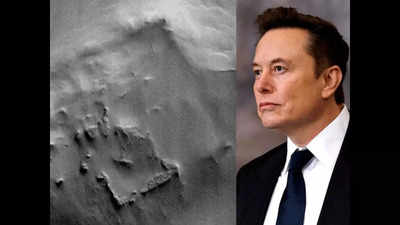[ad_1]
A recent discovery on the surface of Mars has generated significant curiosity among space enthusiasts and experts alike. A perfectly square-shaped structure, approximately 3 kilometers (1.8 miles) wide, was spotted in images captured by NASA’s Mars Global Surveyor’s Mars Orbiter Camera (MOC). The geometric anomaly has ignited widespread speculation, with theories ranging from natural geological formations to possible extraterrestrial origins.
Among those intrigued by this discovery is SpaceX CEO Elon Musk, who has called for a direct investigation into the square formation. Musk, known for his ambitious plans to establish human colonies on Mars, quickly took to social media to express his interest in the unusual feature, fueling further discussions about its potential significance.
While some experts suggest that such a formation could be the result of natural planetary processes, the sheer precision of the square has led many to question whether it might be something more mysterious. The discovery has not only intensified debates about life beyond Earth but also reinforced calls for increased exploration of the Red Planet.
Discovery of the square structure on Mars
The peculiar square was first noticed in images taken by NASA’s Mars Global Surveyor (MGS), an orbiter that conducted extensive mapping of Mars between 1997 and 2006. While the spacecraft was decommissioned in 2006, the vast amount of data it collected continues to be analyzed, occasionally revealing intriguing new details about Mars’ surface.
The square formation is located in an area of rocky terrain, where erosion, tectonic activity, and other geological processes are known to shape the landscape. However, what makes this discovery particularly unusual is the near-perfect angular geometry of the structure—something rarely seen in naturally occurring rock formations.
As soon as images of the formation began circulating online, speculation took off, with many questioning whether the square was a natural geological feature or evidence of something artificial.
Elon Musk wants answers about the perfect square found on Mars
Elon Musk, a vocal advocate for interplanetary colonization, wasted no time in addressing the mystery. After well-known podcaster Joe Rogan reposted the image with a caption expressing astonishment, Musk responded with his own bold statement: “We should send astronauts to Mars to investigate!”
Musk’s enthusiasm is not surprising. As the founder of SpaceX, he has spent the past two decades pushing the boundaries of space exploration. His company has successfully launched and landed reusable rockets, developed the Starship spacecraft for deep-space missions, and set a goal of landing humans on Mars within the next decade.
The discovery of the Martian square may serve as additional motivation for Musk and his team to accelerate their efforts. While SpaceX has been preparing for a crewed Mars mission, this latest development could provide a compelling reason to prioritize exploration of this specific site.
Debate over the square structure origin on Mars
The discovery of the square structure has sparked an intense debate, both among scientists and on social media. Several theories have emerged to explain the unusual feature:
- A natural geological formation?
Some geologists argue that the square’s angular shape could be the result of fracturing and erosion. On Earth, similar formations have been observed in regions where volcanic activity, tectonic movements, and wind erosion have shaped rock surfaces over millions of years.
Another possibility is that the formation appears square due to shadows, lighting, or image distortion. In past instances, formations like the famous “Face on Mars” were later determined to be natural hills and rock formations that appeared artificial due to the angle of sunlight and resolution of early images.
- Evidence of extraterrestrial structures?
Despite scientific explanations, many online theorists have jumped to more speculative conclusions, suggesting that the square might be evidence of an artificial structure—perhaps remnants of an ancient civilization or an alien-built base.
A user on social media wrote, “Humans invented squares. Before we were there, they did not exist. Aliens.” Another speculated, “What if it’s similar to the base of the Pyramids in Giza? What if we’re looking at the remains of something ancient?”
While there is currently no concrete evidence to support the idea of artificial structures on Mars, discoveries like this continue to fuel interest in extraterrestrial life and advanced civilizations beyond Earth.
How NASA and SpaceX could investigate
If the square formation proves to be of significant interest, NASA and SpaceX could use several methods to investigate further:
NASA’s Mars Reconnaissance Orbiter (MRO), which carries the HiRISE camera, is capable of capturing high-resolution images of the Martian surface. These images could provide a more detailed look at the square’s texture, composition, and possible origins.
A future rover mission could be sent to examine the formation up close, much like Perseverance and Curiosity have done in other regions of Mars.
If Musk’s ambitions come to fruition, a manned SpaceX mission to Mars could eventually allow astronauts to explore the site directly, conducting geological studies and collecting samples for further analysis.
The future of Mars exploration
Regardless of whether the Martian square turns out to be a natural formation or something more mysterious, the discovery highlights the need for continued exploration of Mars.
Upcoming missions to Mars
- NASA’s Artemis Program aims to establish a lunar base, which could serve as a stepping stone for future Mars missions.
- SpaceX’s Starship program is actively working toward launching crewed missions to the Red Planet within the next decade.
- International agencies, including ESA (European Space Agency) and CNSA (China’s National Space Administration), have also announced plans for Mars exploration.
[ad_2]
Source link
